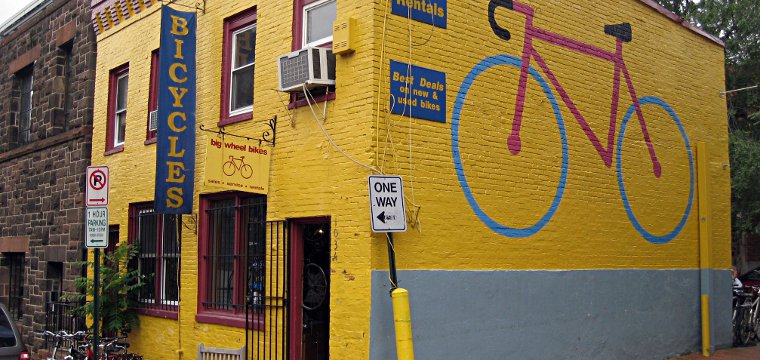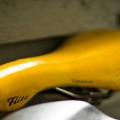The more feedback you get on the brand of bicycle to buy, the better equipped you will be to make a sound decision. Reading bicycle reviews by other riders is a really good way of getting informed, plus you could search or post in online forums for more information. We have outlined some of the more popular brands and listed a number of sites you could go to for more information. You can navigate this guide using the links below:
- Which Brands are Best?
- How Much Should I Spend?
- Helpful Websites
- Where to Buy a Bicycle
- Other Considerations
Which Brands are Best?
This is a hard question to answer simply because there are so many different bike companies offering models for every kind of riding. You would need to know a lot about the quality of bikes offered by each company and what the components are like on these bikes; and this information changes from year to year. The price of a bike might give something away in regards its quality, but they could also simply be on sale or just have more expensive or cheaper components.

There are many bicycle brands to choose from. These are some popular, reputable brands that should be available in your area.
Bike shops are usually keen to push the range of bikes they have in stock so they might not give you a completely objective view about brands. You would be best to ask other riders or do some thorough research at a number of stores, magazines and online.
Some reputable bike brands include Specialized, Giant, Avanti, Jamis Bicycles, Mongoose, Trek,GMC, Cadillac, Cannondale and Merida to name just a few. These offer all kinds of models of bikes and many have BMX, mountain bikes, road bikes, touring and comfort models. This is hardly a comprehensive list but you should be able to find them almost anywhere in a decent bike shop. If you can’t find a brand in the list, a simple online search will reveal more about it. Most bike brands have their own websites and can provide you with detailed information.
How Much Should I Spend?
Bikes cost anywhere from $100 to more than $10,000. Beginner cyclists may consider spending just a few hundred dollars but the old adage of “you get what you pay for” works here. If you’re cycling just a few miles each day to work and back, you might only need a cheaper, cruiser style bicycle that costs very little. But if you actually had a better bike it might encourage you to use it more. A reasonably good bike will set you back about $1,000 for something of quality, although if you shop around you might find some better deals. However if you consider that cycling can and does save you money on other forms of transportation, travel and even on your health long term; a more expensive bike can be warranted.
While a $1,000 bike may cost the same as getting a scooter, motorbike or cheap car you won’t have to pay insurance, fuel costs, parking or registration fees. And if you’re purchasing a bike for social, recreational or fitness reasons it can still end up cheaper than other things you may have once done in that free time. (eg. gone to a movie, the gym etc.) Expensive bikes might have more expensive components and cost more to service and replace but they generally have a much longer shelf life. Cheaper bikes are cheap because their frames and components are too – they might not stand up to much wear and tear. So it may be better to invest in a higher quality machine in the first place rather than having to replace parts regularly or even the entire bike.
On the flipside if you are purchasing a bicycle for children, it might be best to head to a department store and get them something cheaper. Kids outgrow bikes quickly and if they outlast the first model and prove to be really keen you could get them something more expensive and of better quality later on.
If you don’t have a lot of money don’t be discouraged as there are plenty of outlets where you can get quality discounted bikes such as second hand trading papers, online through eBay and Craigslist, bike clubs or by asking at your local bike shop for used models. Bicycle maintenance is easily learned and service and repair jobs therefore don’t need to cost an arm and a leg either, and a bit of care is also good for your bike’s longevity. Just do try to avoid really cheap department store deals unless you’ve really done your homework on what they’re selling.
If the bike riding is a hobby then you should consider exactly how serious you are about it. If riding is just a phase that will wane in interest after a few months then you’re best not to go all out with your budget initially. You can always upgrade your bike when you prove you’re in there for the long term.
The thing that adds to cycling costs is the expensive gear, accessories and entry to various rides. Cyclists can easily become seduced by all the latest stuff but really you need very little other than the bike itself and a helmet. Try to think rationally about exactly how much use you will get out of particular clothing and accessories. For example if you are only commuting to work you could wear your own shorts and shirt to save you purchasing bike jerseys and shorts.
Helpful Websites
Make sure you read review websites, forums, and bike magazines to get some unbiased feedback on the types of bikes available. With that in mind we have compiled a short list of sites to check out, and there are plenty more out there.
Online Publishers and Bicycle reviews

MTB Review – Product reviews, ratings, and classifieds for mountain bikes and an online forum.

Road Bike Review – Reviews of road bikes, parts and accessories.

Road Cycling – Some bike, parts and accessory reviews, also interviews, forums and more for the road cyclist.
Cycling News – High end and professional racing bike reviews.

RIDEbmx – An informative BMX site with product reviews written by riders.

Bicycling Magazine – Road cycling magazine with bikes, gear, training and maintenance reviews and tips. Information for cyclists of all levels.
Singletrack Magazine – Mountain biking magazine with bike reviews, trail guides and forums. (UK based)
Bicycling Forums

Bike Forums – A discussion forum with everything from bike mechanics to commuting to work and buying classic or vintage bicycles.

Cycling Forums – Cycling and bicycle racing discussion forums. A good place to go if you’re looking for a new bike, getting advice, etc. both in the US and Canada, Europe, Africa, Asia and Australia.
Where to Buy a Bicycle
You have several very good choices to pick from when deciding where to buy your bike. These inclue local bike shops, retail department stores, online retailers and online marketplaces. Depending on how much you know about bicycles, what you’re looking for and how much you want to spend, you can certainly find a suitable bike at one of these places.
Local Bike Shops
Local bike shops are the best place to get advice on buying the bicycle. Usually the people working there know and love bikes and are riders themselves. They can tell you all the great local places to ride and might even have cycling groups that meet at their shop that are happy to include you. They are also a good place to purchase a bike or accessories as they will know how to fix them when things go wrong. Having said that bike shops can be more expensive than online or local department stores and it’s always wise to compare prices.
Pros
- Expert service and fitting
- Variety of high quality bicycle brands
- You can test ride many bicycles
- Maintenance and repair services
- Returns are easy
- Bikes are delivered assembled and ready to ride
Cons
- More Expensive
- Store hours may be limited

Your local bike shop will certainly offer the most hands-on, helpful and informative shopping experience. | Image © Jim’s Bicycle Shop – Cincinnati, OH
Online Retailers and Marketplaces
It is increasingly possible to find high quality bikes, components, accessories and other equipment for sale online. In fact, you may find some pretty good deals. In addition to online only dealers, many retail stores and local bike shops offer online shopping too. So whether you’re buying a complete bike or something specific, it’s worth taking a look.
As with all purchases that are made online you should know exactly what you are buying. These companies do have to abide by certain rules but you should perform a few standard checks yourself. If you see a bike advertised online, go down to your local store and ask about it. It may well be cheaper in a used variety online than what they are selling, however you shouldn’t really buy without seeing the item and/or going for a test ride. Is the online seller allowing you to come and see the bike? Don’t send money advances before you’ve done this or have some assurance about a returns policy if it’s not quite what you want.
Pros
- 24 hour shopping
- Wide variety of bicycle brands
- Competitive pricing
Cons
- No expert assistance with bicycle selection and fitting
- No test rides
- Bicycle assembly may be required
- Returns require shipping
Local Department Stores
Bike shops will undoubtedly give you the best specific, professional advice and try to find products that cater to your needs, however local department stores can also help. If there are no bike shops in your area they may be the only resource you have anyway. Besides you will be protected by the organization’s good name and they are likely to have a return policy. However be prepared that the salespeople usually have general training only and may not have detailed product information.
They are also unlikely to cater to individual needs and might not have the top of the range equipment or brands. They are more likely to have mass-produced, low-end models. The more research you do before entering a department store will enable you to make an informed choice about the products on sale. For example, of the bikes that are there, you might have to determine yourself if they are road, hybrid or mountain bikes and if they will cater for your needs. If there is something there you like and want to try out you might have to fit the frame, seat and handlebars yourself and work out a trial riding route. However things like inner tubes, bike repair kits, bike bags and pumps can actually be cheaper here than specialist stores and the quality reasonable.
Pros
- Stock wide array of bicycles and accessories
- Less expensive
- Practically open all the time
- Returns are easy
Cons
- Limited expertise and fitting facilities
- Entry-level bicycle brands
- Useful test rides are difficult, if not impossible
- Bicycle assembly may be required
Other Considerations
Some other considerations to make bicycle assembly, return policy and servicing that will be involved with a bike after the purchase.
Assembly
It’s a good idea to make sure assembly is included with the purchase of your bicycle. Most bike shops will sell an assembled bike, fit it for you and allow a test ride. However if you are purchasing a bike from a department store, online or by some other method involving shipping; it might not be fully assembled. This shouldn’t dissuade you from the purchase. However it’s good to check out in advance and make sure someone can assist you if you are not confident enough to put pedals, handlebars and seats on a frame yourself. Alternatively you could take it down to a bike shop once it arrives.
Maintenance and Repair
All bikes will require regular servicing to fine tune, adjust or correct problems. It is a good idea to get a local bike shop to look over it from time to time but there are a lot of things you can do yourself. Having a basic knowledge of simple maintenance will save you a lot of angst, money and time in the long run. For example you can do things like keeping your chain clean and oiled with a lubricant. This is a good way of prolonging its life and enabling you to change gears smoothly. You should also keep your tires at the correct pressure and check them every time you go out for a ride. This will help prevent punctures and unnecessary wear of your rims and your tires. It’s also very important to keep your bike clean. You should wash off mud, road grease and any other dirt that may damage the paintwork and get stuck in your chain or gears; off road riders should do this after every ride. Some things, like your brakes and chain, will need to be replaced from time to time so keep an eye on their wear and movement.

Most local bike shops have maintenance and repair facilities to service your bicycle | Image © Competitive Cyclist
Return Policy
If you purchase the bicycle from a friend or a private seller there is unlikely to be any return policy. However bike shops and department stores are likely to have a return policy. Check what this is before committing to the sale and what the conditions are for returning it.
Featured Image Credit
- Yellow brick bike shop – Image © koshalek / flickr






Great article
I am in the market for a new bicycle and am struggling to find the right one. I found this article and think it does a wonderful job of walking the user through the process and offers good information. I think the bike sizing chart and calculators were very helpful and I have a much better understanding know what to look for while test riding bikes.
Great website
I love this website. My two bikes just got stolen out of our garage so i am looking for a replacement. This completely covers all info for new time bike buyers or previous bike owners.